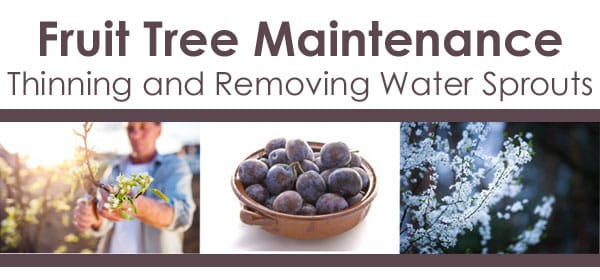Newsletter Articles
Fruit Tree Maintenance – Thinning and Removing Water Sprouts
By Richard Flowers, ACCNP-Green Thumb Nursery-Ventura
On my property I have two Burgundy Plum fruit trees. These Burgundy Plums provide me with delicious, sweet, juicy, fruit with a little hint of tartness in July into August. With all the rain and adequate winter chilling this past season, I will be getting a bumper crop this year. There must be over 300 pieces of fruit between the two trees and I don’t know what I am going to do with all of them. I may need to give the fruit to neighbors, friends, and I am sure the birds and squirrels may get some of the fruit also. Right now the fruits are immature, small, green, and about 3/4 to 1 inch in size, but when they are ripe they will turn a burgundy-red and the interior will be burgundy-red as well, hence the common name Burgundy Plum. Burgundy Plum is self fruit-full, meaning it does not need another variety of Plum to pollinate the flowers.
Today while out in the garden analyzing what needs to be done, I determined that my two Plum trees have specific types of maintenance practices that need to be done at this time of year. With the bountiful fruits and excessive growth, I need to start thinning the fruit, do some pruning, and removing away water sprouts. Thinning fruits involves literally removing fruits that are too close together to one another so other fruits have a chance to produce larger, more high quality fruits, balanced crop production, better flavor, and a better crop next year. Being a stone fruit, I like to thin my Plum to 4-6 inches apart from one another. I start to thin my Plums when they are 3/4 to 1 inch in size (the same rule applies to other stone fruits). Stone fruits are Peaches, Nectarines, and Apricots which have a big seed (stone) in the center of the fruit. Bigger fruits like Peaches can be thinned to 6-9 inches apart. Apples you thin when they are 1/2 to 1 inch in size and thin them to 2-3 pieces of fruit per cluster. Thinning involves going through the entire tree very thoroughly and whereever you see several fruits growing close together you remove those fruits. For example, you have 15 pieces of immature fruit in a short amount of space, you may want to reduce this to 6 pieces of fruit. It is necessary to come back every few days and repeat the process as more and more fruits appear. You are never going to effectively thin a fruit tree the first time around.
When I thin my Plums, I take my thumb and forefinger and gently twist and pull off the unwanted immature fruits and drop them inside a bucket that I hold in my other hand, then toss my thinned pieces of fruit in the compost bin. I make sure to thin in such a
manner as to have equal distribution of fruits on a given branch. When thinning, the fruit that is closest to the tip of the branch is taken off (because it is weaker) and the fruit that is closest to the main branch is left on because it is stronger in that location.
When thinning fruits it is important to know that early ripening varieties (May-July) have minimal time on the tree to ripen and size up, these fruits you need to thin more aggressively than others. Thinning is beneficial for several reasons. Fruit trees that are
thinned reduces the incidence of branch and limb breakage form excessive weight of fruit especially in a bumper crop year. Let’s say you have a branch that has 50 pieces of fruit on it and each fruit when ripe weighs 8 oz this equals 400 ounces or 25 pounds.
Can that branch hold that additional weight or will it break? By thinning out fruits the result will be more air circulation, better sunlight penetration thus creating a higher quality piece of fruit because the fruit will be larger, have more sugars produced in fewer fruits. Thinning fruits reduces the chance of fruit injury or disease. When fruit is too close it could rub against one another and injure it, while on the other hand, closely spaced fruit can develop fruit rot which is a fungus that can spread to other fruits. Also thinning reduces the incidence of premature fruit drop. So I encourage you to survey your fruit trees and thin away. The result will be bigger, more delicious, and a healthier fruit tree.
Also while examining my two Plums, I noticed that a number of water sprouts growing. Water sprouts are straight, vertical growth of branches that grow very fast. These branches do not produce any fruits or the fruits will be low quality. Water sprouts occur
on main branches, limbs, and sometimes on the trunk. By properly removing waterspouts whenever they occur will help the maturing fruits get more sunlight hence a better fruit experience. Since water sprouts are also weaker growing than the rest of the
tree, pruning them off properly before heavy winds break them off is beneficial. Water sprouts also take vigor away form the growing tree. I suggest you go out into your yard and carefully examine your fruit trees and start pruning away those unwanted water sprouts.
While I am thinning the fruits and removing water sprouts I also make special attention to remove any growth that grows inward or inside the fruit tree. I prune these unwanted growths out so I can have good air circulation and light penetration inside the tree to reduce the incidence of insect and diseases. The goal is to have an open center. By practicing these important fruit tree maintenance tips your trees will be more healthier, vigorous, thrive, and produce better quality fruit.
Do you like what you see? Sign up for our weekly newsletter to get content like this every week!

